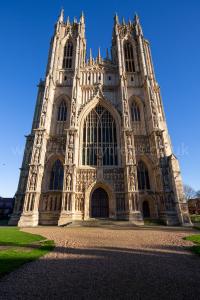Architectural Detail
Architectural Detail is in Architecture.
Culture, General Things, Architecture, Architectural Detail, Baroque
After 29 Apr 1714. St Michael's Church, Stowe Nine Churches [Map]. Monument to Thomas Turner (deceased). Sculpted by Thomas Stayner (age 49). Baldachin. Drapery. Baroque. The figure on the left is Faith who holds a model of a circular church. The figure on the right is Thomas Turner (deceased). Segmental Pediment. Moulded Cornice.
Thomas Turner: In Sep 1645 he was born to Dean Thomas Turner and Margaret Windebank. Evelyn's Diary. 20 Dec 1685. Dr Turner, brother to yc Bp. of Ely, and sometime Tutor to my son, preach'd at Whitehall on 8 Mark 38, concerning ye submission of Christians to their persecutors, in were some passages indiscreete enough, considering yc time, and the rage of the inhumane French tyrant against the poore Protestants. On 29 Apr 1714 he died.
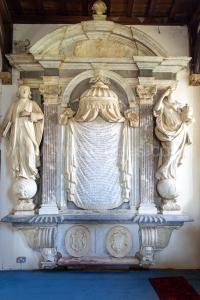
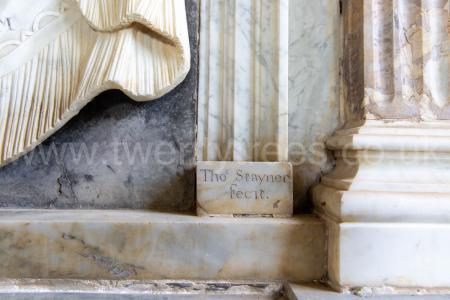
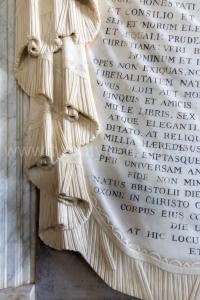
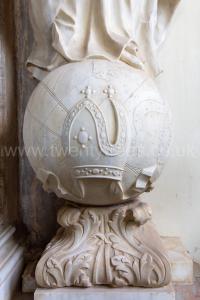
Culture, General Things, Architecture, Architectural Detail, Caryatid
Around 1578. Church of the Holy Trinity, Bosbury [Map]. Monument to Richard Harford died 1578.
Large recessed wall Elizabethan Period monument commemorating Richard Harford died 1578, his wife Martha and Anthony Harford, attributed improbably to John Guldo of Hereford, caryatid-type figures possibly Adam and Eve flank central semi-circular headed arched recess with segmental pediment. Two recumbent effigies, male and female in civil costume on sarcophagus supported by two grotesque animals, the whole enriched with foliage and flock motifs and rather more primitive in style than John Harford memorial on opposite wall.
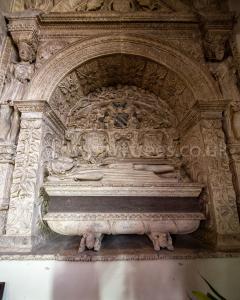
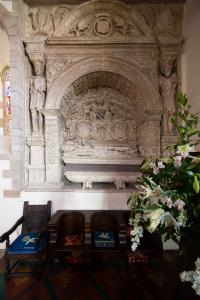
Before 1736. Monument to Anne Brudenell (wife of Charles Lennox) in St Peter's Church, Deene [Map] by Giovanni Battista Guelphi (age 45) on the west wall of the transept. Bust set against square surround with flanking caryatids, metope frieze and pediment over.
Giovanni Battista Guelphi: Church of St Peter Kirkthorpe. The chief merit of the church is a fine collection of C18 wall monuments. The most important of these is the Stringer Monument by Guelfi: 2 detached busts on a sarcophagus with straight tapering sides; background by Kent with inscription, a frame starting from 2 big volutes and crowned by an open-segmental pediment carved coat-or-arms with putti. The Smyth chapel has numerous monuments dating from 1731; including that to John Smyth of 2 putti uncovering his portrait on an oval medallion, that to Lady Georgina Smyth and others signed by Flaxman; 1799. Around 1690 he was born. In 1736 he died.
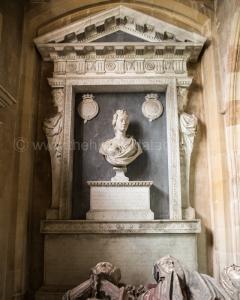
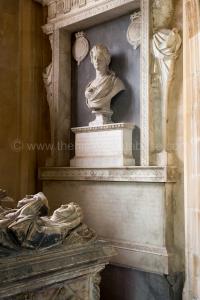
Culture, General Things, Architecture, Architectural Detail, Drapery
After 29 Apr 1714. St Michael's Church, Stowe Nine Churches [Map]. Monument to Thomas Turner (deceased). Sculpted by Thomas Stayner (age 49). Baldachin. Drapery. Baroque. The figure on the left is Faith who holds a model of a circular church. The figure on the right is Thomas Turner (deceased). Segmental Pediment. Moulded Cornice.
Thomas Turner: In Sep 1645 he was born to Dean Thomas Turner and Margaret Windebank. Evelyn's Diary. 20 Dec 1685. Dr Turner, brother to yc Bp. of Ely, and sometime Tutor to my son, preach'd at Whitehall on 8 Mark 38, concerning ye submission of Christians to their persecutors, in were some passages indiscreete enough, considering yc time, and the rage of the inhumane French tyrant against the poore Protestants. On 29 Apr 1714 he died.




Culture, General Things, Architecture, Architectural Detail, Festoon
Evelyn's Diary. 17 Nov 1644. I walked to Villa Borghese, a house and ample garden on Mons Pincius, yet somewhat without the city walls, circumscribed by another wall full of small turrets and banqueting-houses; which makes it appear at a distance like a little town. Within it is an elysium of delight, having in the centre of it a noble palace; but the entrance of the garden presents us with a very glorious fabric, or rather door-case, adorned with divers excellent marble statues. This garden abounded with all sorts of delicious fruit and exotic simples, fountains of sundry inventions, groves, and small rivulets. There is also adjoining to it a vivarium for ostriches, peacocks, swans, cranes, etc., and divers strange beasts, deer, and hares. The grotto is very rare, and represents, among other devices, artificial rain, and sundry shapes of vessels, flowers, etc.; which is effected by changing the heads of the fountains. The groves are of cypress, laurel, pine, myrtle, and olive. The four sphinxes are very antique, and worthy observation. To this is a volary, full of curious birds. The house is square with turrets, from which the prospect is excellent toward Rome, and the environing hills, covered as they now are with snow, which indeed commonly continues even a great part of the summer, affording sweet refreshment. Round the house is a baluster of white marble, with frequent jettos of water, and adorned with a multitude of statues. The walls of the house are covered with antique incrustations of history, as that of Curtius, the Rape of Europa, Leda, etc. The cornices above consist of fruitages and festoons, between which are niches furnished with statues, which order is observed to the very roof. In the lodge, at the entry, are divers good statues of Consuls, etc., with two pieces of field artillery upon carriages, (a mode much practiced in Italy before the great men's houses) which they look on as a piece of state more than defense. In the first hall within, are the twelve Roman Emperors, of excellent marble; between them stand porphyry columns, and other precious stones of vast height and magnitude, with urns of oriental alabaster. Tables of pietra-commessa: and here is that renowned Diana which Pompey worshiped, of eastern marble: the most incomparable Seneca of touch, bleeding in an huge vase of porphyry, resembling the drops of his blood; the so famous Gladiator, and the Hermaphrodite upon a quilt of stone. The new piece of Daphne, and David, of Cavaliero Bernini, is observable for the pure whiteness of the stone, and the art of the statuary plainly stupendous. There is a multitude of rare pictures of infinite value, by the best masters; huge tables of porphyry, and two exquisitely wrought vases of the same. In another chamber, are divers sorts of instruments of music: among other toys that of a satyr, which so artificially expressed a human voice, with the motion of eyes and head, that it might easily afright one who was not prepared for that most extravagant sight. They showed us also a chair that catches fast any one who sits down in it, so as not to be able to stir out, by certain springs concealed in the arms and back thereof, which at sitting down surprises a man on the sudden, locking him in by the arms and thighs, after a true treacherous Italian guise. The perspective is also considerable, composed by the position of looking-glasses, which render a strange multiplication of things resembling divers most richly furnished rooms. Here stands a rare clock of German work; in a word, nothing but what is magnificent is to be seen in this Paradise.
Evelyn's Diary. 29 Jan 1645. The next day, having passed [the river] Vulturnus, we come by the Torre di Francolisi, where Hannibal, in danger from Fabius Maximus, escaped by debauching his enemies; and so at last we entered the most pleasant plains of Campania, now called Terra di Lavoro; in very truth, I think, the most fertile spot that ever the sun shone upon. Here we saw the slender ruins of the once mighty Capua, contending at once both with Rome and Carthage, for splendor and empire, now nothing but a heap of rubbish, except showing some vestige of its former magnificence in pieces of temples, arches, theatres, columns, ports, vaults, colosses, etc., confounded together by the barbarous Goths and Longobards; there is, however, a new city, nearer to the road by two miles, fairly raised out of these heaps. The passage from this town to Naples (which is about ten or twelve English post miles) is as straight as a line, of great breadth, fuller of travelers than I remember any of our greatest and most frequented roads near London; but, what is extremely pleasing, is the great fertility of the fields, planted with fruit trees, whose boles are serpented with excellent vines, and they so exuberant, that it is commonly reported one vine will load five mules with its grapes. What adds much to the pleasure of the sight is, that the vines, climbing to the summit of the trees, reach in festoons and fruitages from one tree to another, planted at exact distances, forming a more delightful picture than painting can describe. Here grow rice, canes for sugar, olives, pomegranates, mulberries, citrons, oranges, figs, and other sorts of rare fruits. About the middle of the way is the town Aversa, whither came three or four coaches to meet our lady travelers, of whom we now took leave, having been very merry by the way with them and the capitáno, their gallant.
Evelyn's Diary. 17 Apr 1645. The next day Mr. Henshaw and I spent the morning in attending the entrance and cavalcade of Cardinal Medici, the ambassador from the Grand Duke of Florence, by the Via Flaminia. After dinner, we went again to the Villa Borghese, about a mile without the city; the garden is rather a park, or a Paradise, contrived and planted with walks and shades of myrtles, cypress, and other trees, and groves, with abundance of fountains, statues, and bass-relievos, and several pretty murmuring rivulets. Here they had hung large nets to catch woodcocks. There was also a vivary, where, among other exotic fowls, was an ostrich; besides a most capacious aviary; and, in another inclosed part, a herd of deer. Before the palace (which might become the court of a great prince) stands a noble fountain, of white marble, enriched with statues. The outer walls of the house are encrusted with excellent antique bass-relievos, of the same marble, incornished with festoons and niches set with statues from the foundation to the roof. A stately portico joins the palace, full of statues and columns of marble, urns, and other curiosities of sculpture. In the first hall were the Twelve Cæsars, of antique marble, and the whole apartments furnished with pictures of the most celebrated masters, and two rare tables of porphyry, of great icon. But of this already: for I often visited this delicious place.
Evelyn's Diary. 21 May 1645. Visiting the Duke's repository again, we told at least forty ranks of porphyry and other statues, and twenty-eight whole figures, many rare paintings and relievos, two square columns with trophies. In one of the galleries, twenty-four figures, and fifty antique heads; a Bacchus of M. Angelo, and one of Bandinelli; a head of Bernini, and a most lovely Cupid, of Parian marble; at the further end, two admirable women sitting, and a man fighting with a centaur; three figures in little of Andrea; a huge candlestick of amber; a table of Titian's painting, and another representing God the Father sitting in the air on the Four Evangelists; animals; divers smaller pieces of Raphael; a piece of pure virgin gold, as big as an egg. In the third chamber of rarities is the square cabinet, valued at 80,000 crowns, showing on every front, a variety of curious work; one of birds and flowers, of pietra-commessa; one, a descent from the cross, of M. Angelo; on the third, our Blessed Savior and the Apostles, of amber; and, on the fourth, a crucifix of the same. Between the pictures, two naked Venuses, by Titian; Adam and Eve, by Durer; and several pieces of Portdenone, and del Frate. There is a globe of six feet diameter. In the Armory, were an entire elk, a crocodile, and among the harness, several targets and antique horse-arms, as that of Charles V.; two set with turquoises, and other precious stones; a horse's tail, of a wonderful length. Then, passing the Old Palace, which has a very great hall for feasts and comedies, the roof rarely painted, and the side walls with six very large pictures representing battles, the work of Gio. Vassari. Here is a magazine full of plate; a harness of emeralds; the furnitures of an altar four feet high, and six in length, of massy gold; in the middle is placed the statue of Cosmo II, the bass-relievo is of precious stones, his breeches covered with diamonds; the moldings of this statue, and other ornaments, festoons, etc., are garnished with jewels and great pearls, dedicated to St. Charles, with this inscription, in rubies:
Evelyn's Diary. 23 Mar 1646. In a word, this sweet town has more well-built palaces than any of its dimensions in all Italy, besides a number begun and not yet finished (but of stately design) by reason of the domestic dissensions between them and those of Brescia, fomented by the sage Venetians, lest by combining, they might think of recovering their ancient liberty. For this reason, also, are permitted those disorders and insolences committed at Padua among the youth of these two territories. It is no dishonor in this country to be some generations in finishing their palaces, that without exhausting themselves by a vast expense at once, they may at last erect a sumptuous pile. Count Oleine's Palace is near perfected in this manner. Count Ulmarini is more famous for his gardens, being without the walls, especially his cedrario, or conserve of oranges, eleven score of my paces long, set in order and ranges, making a canopy all the way by their intermixing branches for more than 200 of my single paces, and which being full of fruit and blossoms, was a most delicious sight. In the middle of this garden, was a cupola made of wire, supported by slender pillars of brick, so closely covered with ivy, both without and within, that nothing was to be perceived but green; between the arches there dangled festoons of the same. Here is likewise a most inextricable labyrinth.
Evelyn's Diary. 23 Aug 1662. I was spectator of the most magnificent triumph that ever floated on the Thames, considering the innumerable boats and vessels, dressed and adorned with all imaginable pomp, but, above all, the thrones, arches, pageants, and other representations, stately barges of the Lord Mayor and companies, with various inventions, music, and peals of ordnance both from the vessels and the shore, going to meet and conduct the new Queen (age 23) from Hampton Court [Map] to Whitehall [Map], at the first time of her coming to town. In my opinion, it far exceeded all the Venetian Bucentoras, etc., on the Ascension, when they go to espouse the Adriatic. His Majesty (age 32) and the Queen (age 23) came in an antique-shaped open vessel, covered with a state, or canopy, of cloth of gold, made in form of a cupola, supported with high Corinthian pillars, wreathed with flowers, festoons and garlands. I was in our newly built vessel, sailing among them.

Evelyn's Diary. 28 Aug 1670. Windsor was now going to be repaired, being exceedingly ragged and ruinous. Prince Rupert (age 50), the Constable, had begun to trim up the keep or high round Tower, and handsomely adorned his hall with furniture of arms, which was very singular, by so disposing the pikes, muskets, pistols, bandoleers, holsters, drums, back, breast, and headpieces, as was very extraordinary. Thus, those huge steep stairs ascending to it had the walls invested with this martial furniture, all new and bright, so disposing the bandoleers, holsters, and drums, as to represent festoons, and that without any confusion, trophy-like. From the hall we went into his bedchamber, and ample rooms hung with tapestry, curious and effeminate pictures, so extremely different from the other, which presented nothing but war and horror.
Evelyn's Diary. 18 Jan 1671. This day I first acquainted his Majesty (age 40) with that incomparable young man, Gibbon (age 22), whom I had lately met with in an obscure place by mere accident, as I was walking near a poor solitary thatched house, in a field in our parish, near Sayes Court, Deptford [Map]. I found him shut in; but looking in at the window, I perceived him carving that large cartoon, or crucifix, of Tintoretto, a copy of which I had myself brought from Venice, where the original painting remains. I asked if I might enter; he opened the door civilly to me, and I saw him about such a work as for the curiosity of handling, drawing, and studious exactness, I never had before seen in all my travels. I questioned him why he worked in such an obscure and lonesome place; he told me it was that he might apply himself to his profession without interruption, and wondered not a little how I found him out. I asked if he was unwilling to be made known to some great man, for that I believed it might turn to his profit; he answered, he was yet but a beginner, but would not be sorry to sell off that piece; on demanding the price, he said £100. In good earnest, the very frame was worth the money, there being nothing in nature so tender and delicate as the flowers and festoons about it, and yet the work was very strong; in the piece was more than one hundred figures of men, etc. I found he was likewise musical, and very civil, sober, and discreet in his discourse. There was only an old woman in the house. So, desiring leave to visit him sometimes, I went away.
On 20 Jan 1770 Charles Yorke (age 47) died. He was buried at St Andrew's Church, Wimpole [Map]. Grey marble obelisk on break-front pedestal of white marble with inscription tablet flanked by festoons and frieze carved with emblems of the Chancellor's office; at the base of the obelisk two putti unveil a portrait medallion and at the apex is an achievement of arms; signed 'P. SCHEEMAKER (age 79) FaT'.
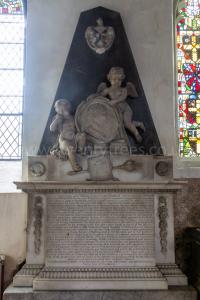
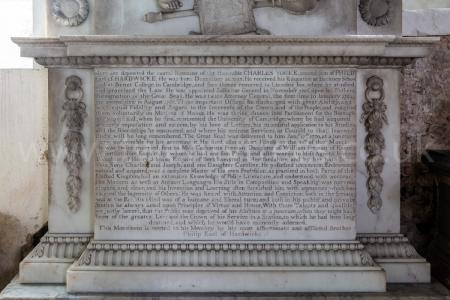
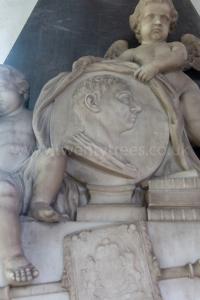
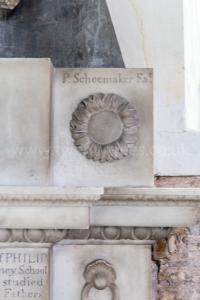
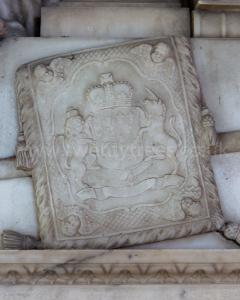
Culture, General Things, Architecture, Architectural Detail, Ogee Arch
In 1406 John Curzon died. Monument in All Saints Church, Kedleston [Map]. Fluted Period. Lancastrian Esses Collar. Reset in tomb recess with depressed crocketed and pinnacled ogee arch, with shields above. This effigy is somewhat anomalous being much earlier than other Fluted Period effigies. It may have been decades after John Curzon died, or may be a mis-attribution, or the effigy may have been placed into the arch from another monument at a later date.
John Curzon: John Curzon and Eleanor Twyford were married. he was born to Roger Curzon.
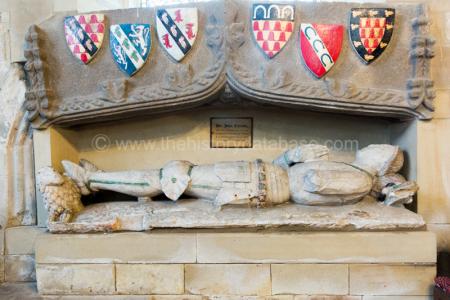
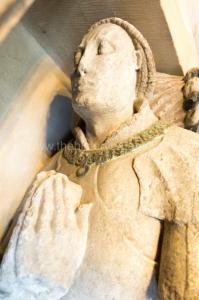
Culture, General Things, Architecture, Architectural Detail, Sideboard Tomb
On 19 Sep 1580 Catherine Willoughby Duchess Suffolk (age 61) died. Her son Peregrine Bertie 13th Baron Willoughby (age 24) succeeded 13th Baron Willoughby de Eresby. Mary Vere Baroness Willoughby Eresby by marriage Baroness Willoughby de Eresby.


She was buried at St James' Church, Spilsby [Map] with her second husband Richard Bertie Baron Willoughby (age 63). Elizabethan Period. Sideboard Tomb. Cornice supported by three figures of a monk and two wildmen, each holding aloft a shield of arms. In the frieze are flowers, fruit and escutcheons.
Mary Vere Baroness Willoughby Eresby: she was born to John de Vere 16th Earl of Oxford and Margery Golding Countess of Oxford. On 25 Dec 1577 Peregrine Bertie 13th Baron Willoughby and she were married. She the daughter of John de Vere 16th Earl of Oxford and Margery Golding Countess of Oxford. He the son of Richard Bertie Baron Willoughby and Catherine Willoughby Duchess Suffolk. Around 24 Jun 1624 Mary Vere Baroness Willoughby Eresby died.
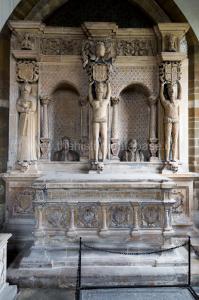
On 25 Jun 1601 Peregrine Bertie 13th Baron Willoughby (age 45) died at Berwick on Tweed [Map]. His son Robert Bertie 1st Earl Lindsey (age 18) succeeded 14th Baron Willoughby de Eresby. He was buried at St James' Church, Spilsby [Map].
On 15 Feb 1610 Catherine Bertie (age 15) died in childbirth. She was buried at St James' Church, Spilsby [Map].
Monument Elizabethan Period. Tall Sideboard Tomb with reclining hooded figure of Lady Katherine, daughter of Peregrine, with Chrisom Child in the crib at her feet. Above a standing figure of Peregrine Bertie 13th Baron Willoughby (age 45) in a niche, with strapwork embellishments, all supported on composite columns with a dentilated cornice.
Catherine Bertie: Around 1595 she was born to Peregrine Bertie 13th Baron Willoughby and Mary Vere Baroness Willoughby Eresby. Sources are confused about her birth year stating she was born in 1610 and that she married in 1609. Date adjusted to around 1595 on the assumption she was married around twenty years of age. Her son died at six days old on 09 Feb 1610. Her father died in 1601. Sources also refer to her as Baroness Rockingham whereas she died some eleven years before her husband was created Baron Rockingham. In 1609 Lewis Watson 1st Baron Rockingham and she were married.
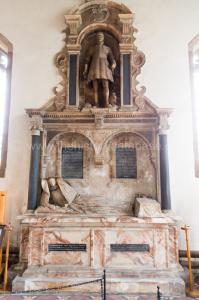
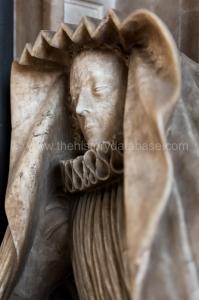
In 1708. Albemarle Bertie (age 40) erected a monument to members of the Bertie Family in Church of St Michael and All Angels, Edenham [Map]. A large, semi-circular headed Sideboard Tomb supporting a black Sarcophagus with gadrooned top and lions feet, erected 1738. Commemorates seven members of the Bertie family. The rear has a marble surround with egg and dart moulding and scrolled imposts with Cartouche of arms to the top. Within are seven classical busts, supported on moulded corbels.[Source: BLB].
Albemarle Bertie: Around 1668 he was born to Robert Bertie 3rd Earl Lindsey and Elizabeth Wharton Countess Lindsey. In 1728 Philip Bertie died without issue. He left his esate to his brother Albemarle Bertie. In 1742 Albemarle Bertie died.
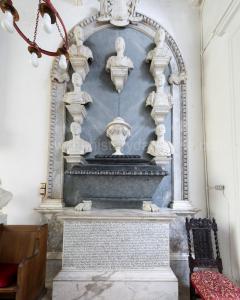
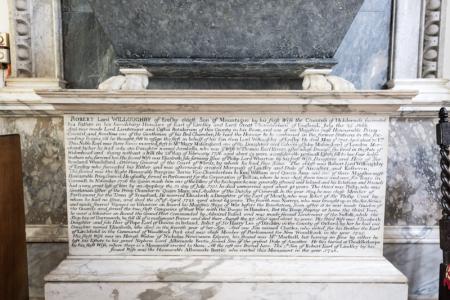
Culture, General Things, Architecture, Architectural Detail, West Facade
Around 1230. The West Facade of Peterborough Cathedral [Map]. Early English Gothic style. The three arches with Recesses unique.
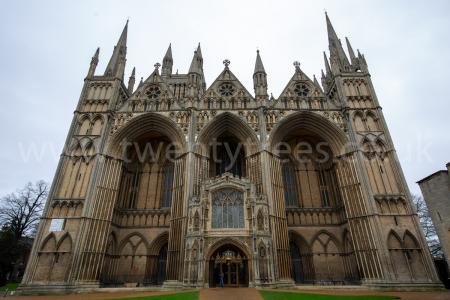
Beverley Minster [Map] West Facade.
